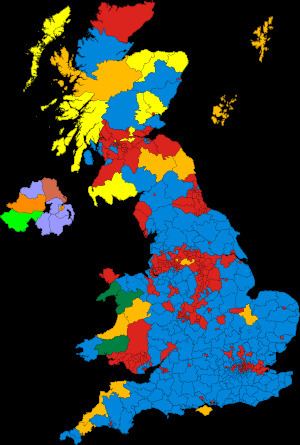10 October 1974 1979 → 301 seats, 37.2% 297 seats, 37.9% 18 20 Start date October 10, 1974 | Turnout 72.8% (6.0%) 319 277 11,457,079 10,462,565 | |
 | ||
Winner Harold Wilson | ||
The United Kingdom general election of October 1974 took place on 10 October 1974 to elect 635 members of the House of Commons of the United Kingdom. It was the second general election of that year and resulted in the Labour Party led by Harold Wilson winning an overall majority of just 3 seats.
Contents
- Campaign
- Timeline
- Results
- Conservative
- Liberal
- Ulster Unionist Party
- Democratic Labour
- Independent Labour
- Labour
- Manifestos
- References
The election of February that year had produced an unexpected hung parliament. Coalition talks between the Conservatives and other parties such as the Liberals and the Ulster Unionists failed, allowing Labour leader Harold Wilson to form a minority government. The October campaign was not as vigorous or exciting as the one in February. Despite continuing high inflation, Labour was able to boast that it had ended the miners' strike, which had dogged Heath's premiership, and had returned some stability. The Conservative Party, still led by Edward Heath, released a manifesto promoting national unity; however their chances of forming a government were hindered by the Ulster Unionist Party refusing to take their whip at Westminster in response to the Sunningdale Agreement of 1973.
In the election the Labour Party won 319 seats, allowing them to form a majority government, albeit with a majority of only 3. The Conservatives and the Liberals each saw their vote share fall, and Conservative leader Edward Heath, who had lost three of the four elections he contested, was ousted as party leader in February 1975 and replaced with future Prime Minister Margaret Thatcher. The Scottish National Party won 11 of Scotland's 71 seats and 30% of the Scottish popular vote, their best Westminster representation until 2015. Subsequently, Labour's narrow parliamentary majority had disappeared by 1977, through a series of by-election losses and defections. They then required deals with the Liberals, the Ulster Unionists, the Scottish Nationalists and the Welsh Nationalists.
This was the last general election won by Labour until 1997: the next four elections all produced an outright Conservative victory.
The election was broadcast live on the BBC, and was presented by David Butler, Alastair Burnet, Robert McKenzie, Robin Day and Sue Lawley.
Campaign
The brief period between the elections gave Wilson the opportunity to demonstrate reasonable progress. Despite high inflation and high balance of trade deficits the miners' strike that had dogged Heath was over and some stability had been restored. Following the February election Heath had remained largely out of the public eye. As was expected, the campaign was not as exciting as the one in February and overall coverage by broadcasters was significantly scaled back. The Conservatives campaigned on a manifesto of national unity, in response to the mood of the public. Labour campaigned on its recent successes in government, and although the party was divided over Europe, their strengths outweighed that of Heath, who knew his future relied on an election victory. As for the Liberals and the SNP Devolution was a key issue and was now one that the two main parties also felt the need to address. As for the Liberal manifesto, they simply reissued the one they had created for the last election.
Timeline
The Prime Minister Harold Wilson made a ministerial broadcast on television on 18 September to announce that the election would be held on 10 October, less than eight months since the previous election. The key dates were as follows:
Results
Labour achieved a swing of 2% against the Conservatives. This was the first time since 1922 that a government had won an overall majority with less than 40% of the vote, albeit a majority of only 3. The Conservatives won just 36% of the vote, their worst share since 1945; and a slight drop in the Liberal vote saw them suffer a net loss of 1 seat. In Scotland, the SNP added another 4 seats to their successes in the previous election to become the 4th largest party.
All parties shown.
